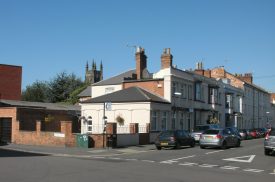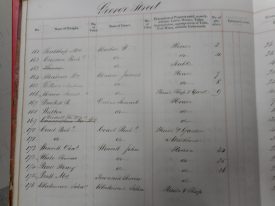The first thing to say is that until some time between 1876 and 1880, the property was actually numbered as 9 George Street. It changed to number 22 when the street was renumbered to take account of new properties that had been built, filling in gaps where gardens etc. had been
With the exception of the parish church, the premises now occupied by H.J. Dawson can probably lay claim to having the longest association with the care of the dead and the bereaved of any building in Leamington.
From the evidence I have been able to find, an undertaking business has been run from these premises since at least 1866, when Morris & Co.’s directory for that year lists the occupier as William George Bloomfield – a builder, undertaker, and contractor of 9 George Street and Chapel Street.
Further back
The association may go even further back than that, as, although living at what was then number 26 George Street, Mr. Bloomfield is listed as being the occupier of the workshop and yard at number 9, going back as far as 1856. He took over the whole of the property between October 1861 and October 1862, running his business from there until his death on 25th April 1906.
Following the death of William Bloomfield, the property and the business was taken over by Henry John Dawson, whose name it bears to this day.
Early maps of the area show that the property once had a fairly large garden on the corner of Chapel Street and George Street. Most of this has now been built on as new offices have been added since the first in 1925. However apart from that, it probably looks much the same as it did when built almost 200 years ago.
1861 census
The 1861 census shows an Elizabeth James living in the property, who seems to have been running it as a lodging house. The rate books for 1860, 1859, and 1858 show an Esther Stanley as resident. There is no occupant listed for 1856 though, as mentioned above, William Bloomfield is listed as occupier of the workshop and yard. From 1855 back the occupier of the whole property is a James Brown, who the 1851 census records as a Builder and Carpenter employing 12 men and three boys.
The rate books number the majority of the houses in George Street back to 1836, and on each occasion James Brown is listed as resident of number 9. The books from 1835 back do not give numbers but by looking at the people either side, we can tell James was still at the same address in 1835. He does not appear in George Street in any of the books for the years before 1835, but it listed as owning a number of properties in Chapel Street back to 1833 .
As the rate book for 1830 only lists four properties in George Street and none in Chapel Street, it is probably fairly safe to assume that James Brown built what is now 22, George Street in 1834.











Comments
Regarding the Browns and Bloomfields mentioned in the interesting article by Richard Neale:
Richard Brown, Master Tailor, married Hannah Satchwell, (daughter of Benjamin Satchwell and Mary Whitmore). They had two sons, but Hannah and their second son both died in 1796. Richard later married Ann Harrison Taylor and they had eight children, many of whom died young. Richard owned property at 34 & 35 Church Street, 4-6 Court Street and 57-59 Regent Street.
Richard and Ann’s son James Brown married Amy Dawkes, daughter of Thomas Dawkes and Mary Pain or Payne. James was a Master Carpenter and Builder in Leamington, as well as a Parish Clerk and Postmaster. His portrait can be seen at the Leamington Art Gallery. It was donated by his granddaughter Amy Mary Spenlove Brown who also donated some of her paintings to the gallery.
James Brown owned 9 George St. It was described in an advert as a “well built and compact family residence, situate and being numbered 9 in George Street, Leamington …… containing a drawing room and two other sitting rooms, kitchen, larder, good cellarage, five comfortable family chambers, water closet, etc, a small enclosed yard at the rear, and, on the south side a walled in garden ……”, and “all that adjacent yard and saw pit, drying sheds, close sheds, capital workshop, office and store room, the whole forming a very excellent premises for a builder, carpenter or cabinet maker.”
1 and 2 Osbourne Place, were built by James as well as those of 7 and 8 George Street. Auctioneer, William Russell, sold the freehold properties of 1-5 Portland Row, inclusive, on his behalf as directed.
Two excellent articles by Darren Bedingfield about James Brown and his father-in-law Thomas Dawkes can be found at:
http://www.leamingtonhistory.co.uk/james-brown/
http://www.leamingtonhistory.co.uk/?s=dawkes
James and Amy’s son, also James Brown, was a Wine and Spirit’s Merchant and Managing Director of Leamington Spa Areated Waters. He was also a founding member of the Oxford Volunteer Fire Service. He was born in Leamington, but he married and lived in Oxford with his spouse Elizabeth Spenlove Cooke, where their children were born. The family returned to Leamington and lived at 118 Parade, and later at 7 Church St.
Amy Dawkes, wife of James Brown, had a sister named Elizabeth Hannah Dawkes who married Isaac Bloomfield. Isaac served in the Napoleonic Wars and served as a Parish Clerk and Registrar of Marriages; he was educated by Rev. John Craig at the Vicar’s grammar school and at Huntingdon Grammer school and was a second master at the Norwich Grammar School; he excelled in maths and classics and was a gifted singer since age 8. He was also a choir master and a private tutor. Isaac and Elizabeth’s son was William George Bloomfield.
Note: William George Bloomfield Sr. and his spouse Sarah Ann Tarver were the parents of William George Bloomfield the undertaker.
In 1946 we moved into 22 George Street when my father, John Taylor, took over the Undertaking business from H J Dawson. We came up from London .some years later he started the business John Taylor Funeral Service. I I remember my father saying that the premises in George Street was always connected to the building and undertaking business.
Edit: I have not been able to prove the death of Richard Brown and Hannah Satchwell’s son William. He may not have died as an infant. I have seen his death on trees as being circa 1796-1797 however I have not been able to document it myself.
John Taylor, re your comment from August, 2018. I wonder if the John Taylor you mentioned was related to the wife of James Brown’s father Richard, that being Ann Harrison Taylor.
Add a comment about this page